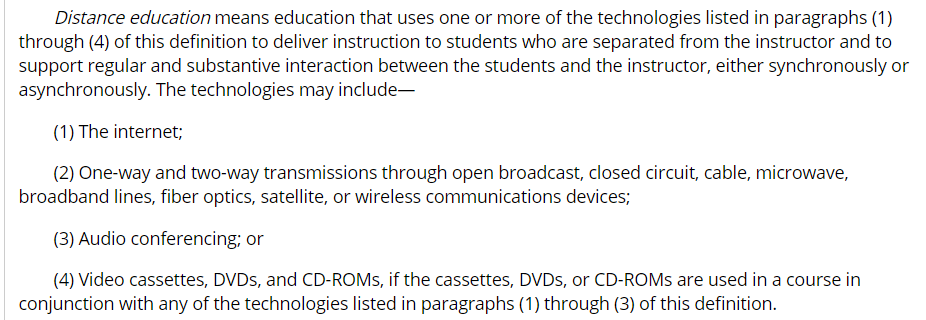Negotiated Rulemaking: The Complexity of “Regular and Substantive Interaction”
Published by: WCET | 4/26/2019
Tags: Distance Education, Negotiated Rulemaking, Online Learning, Student Success, Technology, U.S. Department Of Education, WCET
Published by: WCET | 4/26/2019
Tags: Distance Education, Negotiated Rulemaking, Online Learning, Student Success, Technology, U.S. Department Of Education, WCET
This is the third in our blog post series on the results of the U.S. Department of Education’s negotiated rulemaking process. The first in the series focused an overview of process, issues, and next steps. The second covered rules for state authorization.
Today, we focus on definitions that seem like they should be easy, but quickly become mind-numbingly complex. The definition of “distance education” has the term “regular and substantive interaction” embedded as a key component. Yet, it has not been fully-defined. It is also like the blind men trying to describe the elephant…each interprets it differently from the part that they are able to grasp.
In the recent Negotiated Rulemaking conducted by the U.S. Department of Education, the negotiators tackled this complex issue. This post gives you some insights on the discussions, the language that emerged, and some questions that remain.
The definition of “distance education” was set in place in 1992. Here is the current definition as it appears in Chapter 34, §600.2:

There was a two-fold interest in creating this definition:
The definitions were purposely written in opposition to each other to delineate the two categories of courses. Key in making that distinction was the concept of “regular and substantive interaction” (RSI).
Although RSI is an essential part of the sorting mechanism between the two types of courses, it has never been fully defined by the Department of Education. Yes, we are 27 years later. As a result, it was left to Department auditors to take the small amount of guidance provided and to develop their own criteria.
In 2016, Van Davis (Foghlam Consulting) and Russ Poulin (WCET) wrote a WCET Frontiers blog post about our findings after reviewing previous guidance and audit with RSI findings. We sought to provide our best interpretation of what the auditors were seeking. We also noted that the expectations shifted slightly with each successive audit. This has been a tough problem for institutions, as the goal posts kept moving. Institutional personnel were keen to stay in compliance, so they made it the most read WCET Frontiers post for 2017.
In brief, there were four main criteria:
Unfortunately, the above criteria seemed to have been applied through the lens that face-to-face instruction is the standard and all other modalities need to conform. That is not what the audit reports explicitly said, but that was the impact.

In our opinion, it was time for an update of concepts that were nearly three decades old. However, there were different and often competing priorities that need to be met, including:
We will give you the actual language in italics and highlight the changes for each section…
The Technology Section
Distance education: Education that uses one or more of the technologies listed in paragraphs (1)(i) through (1)(iv) of this definition to deliver instruction to students who are separated from the instructor or instructors, and to support regular and substantive interaction between the students and the instructor or instructors, either synchronously or asynchronously.
(1) The technologies that may be used to offer distance education include—
(i) The internet;
(ii) One-way and two-way transmissions through open broadcast, closed circuit, cable,
microwave, broadband lines, fiber optics, satellite, or wireless communications devices;
(iii) Audio conferencing; or
(iv) Other media used in a course in conjunction with any of the technologies listed in
paragraphs (1)(i) through (1)(iii) of this definition.
This was mostly a minor procedural change to the last bullet. It used to list technologies, such as CD-ROMs and replaced it with “Other media.”
The Instructor Section
(2) For purposes of this definition, an instructor is an individual responsible for delivering course content and who meets the qualifications for instruction established by the institution’s accrediting agency.
This looks deceptively easy now, but the subcommittee and main committee both spent much time on defining “instructor.” The problem is that some institutions have gone to using an unbundled faculty model using a team of instructors. One course may use one person to deliver the content, another to answer questions, and a third to conduct and provide feedback on assessments. All could be knowledgeable about the course content.
For the Western Governors University audit that took place back in 2017, it was found that some of those interacting with students did not meet the auditor’s standards. WGU objected because their model had been approved by their accrediting agency.
The consumer protection advocates requested that any new language be cautious. We did not wish to create a situation in which students were saddled with unqualified “instructors” or worse yet, left students to learn completely on their own.
The committees tried their hands at defining an “instructional team” or a “subject matter expert” and settled on this simpler definition. The language regarding reliance on the “qualifications established by the institution’s accrediting agency” could have helped WGU. Then again, one would have thought that having such approval would have carried the day in the audit.
We think that this definition seems to be on the right track and that it will allow for more options than are currently available. In the end, we will need to see what guidance the Department provides for the rule when they release the regulatory language for public comment in the coming months.
The Substantive Section
3) For purposes of this definition, substantive interaction is engaging students in teaching, learning, and assessment, consistent with the content under discussion, and also includes at least two of the following—
(i) Providing direct instruction;
(ii) Assessing or providing feedback on a student’s coursework;
(iii) Providing information or responding to questions about the content of a course or
competency;
(iv) Facilitating a group discussion regarding the content of a course or competency; or
(v) Other instructional activities approved by the institution’s or program’s accrediting
agency.
The admonition that a “substantive” interaction be one that is “consistent with the content under discussion” is familiar turf. It makes sense as we should focus on the activities that further actual learning or assessment of that learning.
The activities listed seem to flow from a discussion in a December 2014 “Dear Colleague” letter from the Department that Davis and Poulin highlighted in the 2016 blog post. In that letter they list several “educational activities” that can be counted towards compliance.
In follow-up with negotiators on the main committee, they said that these activities would be applied at the course or competency level. That was a relief because, if it was applied at the instructor level, then those whose only role is as assessment experts would not be considered part of the interaction mix.
The negotiators said that they wanted to include this list to assure that some of the activities occur in a course and that it would help ward off “bad actors.” There also seemed to be interest in helping guide institutions as to what activities would be counted towards compliance.
The language is a bit confusing, as it is hard to imagine a course counting towards aid eligibility that included only two of the items on the list. The “substantive” part of RSI was not the big problem in the past, so let’s hope that this new definition will not cause new confusion. Additionally, will the list of activities take us back to the notion that the only interaction that counts is instructor-initiated interaction?
We think that there are great improvements in this language. Again, we hope that the Department provides clear guidance in how this will be interpreted.
The Regular Section
(4) An institution ensures regular interaction between a student and an instructor or instructors by, prior to the student’s completion of a course or competency—
(i) Providing the opportunity for substantive interactions with the student on a
predictable and regular basis commensurate with the length of time and the amount of
content in the course or competency; and
(ii) Monitoring the student’s academic engagement and success and ensuring that an
instructor is responsible for promptly and proactively engaging in substantive
interaction with the student when needed, on the basis of such monitoring, or upon
request by the student.
Again, this looks simple, but it required much sweat, effort, and compromise to get to this place. There was initial interest in helping institutions by given clear standards, such as instructor-initiated interaction at least once per week. Then someone mentioned short courses for which once a week was not enough. The Department proposed a formula depending on the length of the course, but that seem to cause more questions than answers.
There also was great interest in trying to determine how to handle Competency-Based Education or other instructional models that are inherently irregular. It’s a tough job.
There were many drafts on the journey to this final language. The simplicity of the final draft’s wording is enticing.

Adding the word “opportunity” may be a way to make the treatment of distance education and face-to-face classes more equitable. When asked why the Department is not worried about the lack of interaction in a face-to-face course with 500 students, the answer has been that the student has the “opportunity” for interaction with the instructor. We will pause while those in the distance education world cringe.
The first subsection seems to address the traditional notion of interaction being on a “predictable and regular basis.” The second subsection seems to be a nod to courses that are not run in the traditional instructor-led model. The instructor can be highly involved and there is typically more true interaction (not just one-way flow from the instructor) than in a traditional course. Acknowledging different models is a great advance.
However…the word between these two sections was “or” coming out of the subcommittee and was changed to “and” in the main committee. That would be a problem if the course still must follow the old expectations of predictable schedules in a model that does not fit that predictable mold. A negotiator on the main committee said that the change was made because they believed that “or” could create the conditions for a race to the bottom in terms of quality. Allowing for “the opportunity” for substantive interactions in combination with monitoring in (ii) could allow for flexibility.
We still would prefer the “or” and find it hard to see a “race to the bottom” in the second section. The “promptly” and “proactively” seem to set a pretty high bar for responsiveness that would be unattainable in class run by “bad actors.”
Again, it will be interesting to see what guidance the Department provides.
This was a very, very complex and difficult topic to address. Kudos to all the subcommittee and main committee members for the many attempts at getting it right in the limited amount of time that was provided. There are great advances in the language and there are opportunities to meet both the consumer protection and innovation goals set forth by the Department.
Overall, we remain cautiously optimistic. The elements are there, but if they are interpreted poorly, then institutional personnel are right back where we started.
We will all get the chance to have our input on this language once it is released for comment. We are expecting that the language will be available for public comment no later than early summer.
Even with the comments to be received, it is unclear how much of what is proposed the Department will be able to change. In any case, we should raise questions so that we can get guidance that will be as clear as can be.
The ultimate fix (such as a focus on outcomes over process and inputs) will probably have to come from Congress as it reauthorizes the Higher Education Act. We do not want to go another 27 years guessing what we need to do to be in compliance.
For this post, a very special thank you to Cheryl Dowd, Van Davis, and Dan Silverman for their assistance in watching the negotiations, following the issues, and adding input.

Russ Poulin
Senior Director – Policy, Analysis, and Strategic Alliances
WCET – the WICHE Cooperative for Educational Technologies
rpoulin@wiche.edu @russpoulin

5 replies on “Negotiated Rulemaking: The Complexity of “Regular and Substantive Interaction””
Russ, thanks for this analysis and interpretation. Although I agree that this language provides a more useful approach to defining distance education and the interaction of instructors, it makes me wonder how the the determination of student interaction and participation will go. As we analyze their last significant participation for financial aid purposes, how do the statements/definitions above influence that?
The joy continues.
Aaron Bahmer
Director of Instructional Technology
Eastern Wyoming College
[…] via Negotiated Rulemaking: The Complexity of “Regular and Substantive Interaction” — WCET Frontier… […]
[…] This is the fourth and final post in our blog post series on the results of the U.S. Department of Education’s negotiated rulemaking process. You may recall that there were many issues covered by the negotiated rulemaking committee and to our pleasant surprise, consensus was reached. With so many issues, we divided our review of negotiated rulemaking in four sections. The first blog post focused on an overview of the rulemaking process, the issues, and the next steps. The second blog post covered regulations related to state authorization. The third blog post focused on the definition of the complex concept, regular and substantive interaction. […]
[…] “Regular and substantive” interaction between students and instructors. This has long been a complicated issue, and the proposed regulations provide more concrete details than ever before. […]
[…] of new CBE programs. No one knew what the rules really were, especially around the required “regular and substantive” interaction with […]